Updated on April 25, 2025
Along with playing cards, poker chips are a huge part of any game. Chips of varying colors can represent money in a cash game, and certain poker chip values are also used during tournaments.
It’s something most players take for granted.
- Players simply buy in and take a seat at the table.
- They start riffling those poker chips as they wait to get in on the next hand.
But the actual poker chips are a key part of poker games. The number of chips a player receives, and the value of each chip depends on the situation.
Different poker chip colors are used in cash games and tournaments, and this guide offers everything one might need to know about this subject.
Let’s delve into the various poker chip colors, values and denominations across the globe.
Common Poker Chip Values and Colors
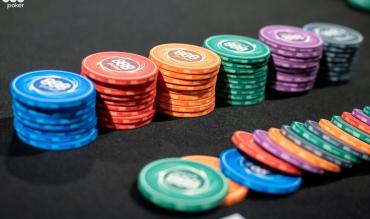
- White - $1
- Red - $5
- Orange - $10
- Yellow - $20
- Green - $25
- Black - $100
- Purple - $500
- Maroon - $1,000
Tournament chip value and colors may differ. It’s essential to note that most tournament chips do not represent actual dollar values. These are merely amounts used throughout the tournament. Players start with a specific amount and hope to increase that as blind levels increase.
Blind levels increase throughout a tournament to intensify the action and eliminate players.Some poker tournaments allow re-entries, and players can receive another starting stack with varying poker chip colors.
As players progress through the tournament, lower-value chips may be “colored off,” meaning that lower-valued chips will be purged from the tables and replaced by chips with larger denominations.
This process makes it easier for players to bet, call, and raise with higher denominations rather than having to count out many more lower-valued chips.
The goal is to accumulate all the chips in play, and ultimately, you will have them all, meaning you’ve won the tournament.
Here’s a look at some examples of tournament values:
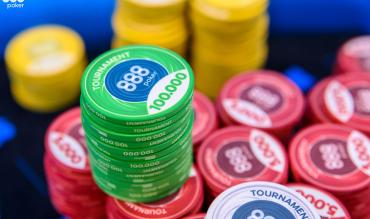
Notice that these do not represent any actual monetary values. So, standard symbols for dollars, pounds, or euros aren’t used.
Poker Chip Values in Tournaments and Cash Games
Players and casinos have long used chips to represent cash and make it easier to wager. A player’s chips are his weapons. They vary in poker chip color value based on the stakes or level in a tournament.
For example, here’s a look at chip values one might find in cash games at a Las Vegas Strip property:
Poker Chip Values and Colors in Poker Tournaments
- White - 25
- Red - 50
- Orange - 100
- Yellow - 500
- Green - 1,000
- Black - 5,000
- Purple - 10,000
It’s essential to note that these colors can vary widely depending on the casino and types of poker games.
Casinos do not have set poker chip color values. While one property may have white and red as the lowest poker chip colors, another may have blue and white. It depends on the casino.
The Basics of Poker Chip Values and Colors
Like cash games, tournament chip colors represent different values. Players begin with a standard number of chips. They hope to build them up throughout the tournament.
Those small, colored markers come in many colors and weights. Players use them in home games, cash games, and major tournaments around the world.

Poker chip values depend on the game or event. Values in cash games directly represent the cash a player has available at the table to gamble. Players in a $1/$2 No Limit Hold’em game who buy in for $300 will receive that amount in chip value.
Poker chip colors vary by casino but tend to follow similar patterns. No set casino standard exists, although white and red tend to be $1 and $5 amounts. Denominations can also go higher for players in high-stakes action.
Some properties, like the Borgata, offer larger-sized chips for higher denominations. These sizes include $500 (purple/yellow) and $1,000 (orange/black).
The larger sizes make it difficult to confuse a high-value chip with other, lower-value poker chip colors in a game with such high stakes.
Check out PokerGO’s popular Poker After Dark for an example of a high-stakes cash game. The show is filmed at the PokerGO Studio at the Aria Resort and Casino. It has featured some of the game’s biggest names and showcases celebrities who enjoy mixing it up on the felt.
Massive pots have been a major part of the action over the last few years. Buy-ins and chip stacks can vary, depending on how much a player wants to buy in chips.
Determining Chip Values and Stack Sizes in a Home Game
If you’re hosting a home game with friends, there are a few things to keep in mind when it comes to the number of chips to use, and the poker chip colors in play. It’s crucial to figure out your tournament structure or cash game chip values in advance.
Working this out is much easier for a cash game. A simple $1-2 or $1-3 (or even lower poker chip color values for lower stakes) No-Limit Hold’em game with six to eight players should be fairly easy. One might decide to make white chips worth $1 and red chips worth $2.
A player buying in for $100 might receive the following chips:
|
Color |
Value |
# of Chips |
|
White |
$1 |
10 ($10) |
|
Red |
$5 |
4 ($20) |
|
Blue |
$10 |
1 ($10) |
Say your stakes are a little higher, and you’re hosting a $2-5 No Limit Hold’em game with the same number of players. You can craft something similar to the above. Most players will typically buy into a game for 50 to 200 big blinds.
Players usually need more denominations and poker chip colors equal to the big blind as that is what they play the most. If you decide to raise the stakes, you may need more chip denominations.
In a bigger game, such as $5-10, a player buying in for $1,000 (100 big blinds) might receive the following poker chips:
|
Color |
Value |
# of Chips |
|
Red |
$5 |
10 ($50) |
|
Blue |
$10 |
10 ($100) |
|
Green |
$25 |
10 ($250) |
|
Black |
$100 |
6 ($600) |
When hosting a tournament, you should make sure of the following ahead of time -
- Chips Inventory – Make sure you have enough for the night’s action.
- Determine the value of those chips – Decide ahead of time what the poker chip colors will be.
- Number of chips per player – Decide how much each player will receive in a tournament or let players buy in for their desired amount in a cash game.
- Chip colors – Select chips in the colors you prefer for specific values and use more common poker chip colors for particular denominations to help avoid confusion.
A small tournament of less than forty people will generally need only four or five colors. A tournament starting with 1,500 chips will find players starting with 60 big blinds.
They’ll begin with Level 1 blinds of 25/25 before advancing to 25/50 and then 50/100. Blind levels may depend on the tournament type, and you will determine the tournament structure and the poker chip values.
Many apps and online sources can help players fine-tune their tournament structures. Some apps can run the tournament for you, including a clock for raising the blind levels.
Here’s an example of the number of tournament chips players might start with in the above scenario.
|
Color |
Value |
Number of Chips |
|
White |
25 |
10 (250) |
|
Red |
50 |
5 (250) |
|
Blue |
100 |
5 (500) |
|
Black |
500 |
1 (500) |
A Look at Major Tournament Chip Values
Like cash games, tournament chips have different colors, representing different values. Players begin with a standard number of chips. They hope to increase those chips throughout the tournament and be the last player standing with all the chips.
Increasing blinds and antes require the addition of larger chip values. Smaller-valued chips are colored up and removed from play.
The World Series of Poker is an excellent example of tournament poker chip colors and values. The annual series is the biggest spectacle and hosts several events on any given day.
The $10,000 buy-in Main Event highlights the action, attracting the best poker players of all time. It is the most-watched event in poker each year. Because there are so many events, organisers use at least five different chip sets

Most WSOP tournaments generally begin with green (25) and black (100) poker chip colors. Tournament organisers switch up colors above those values for different events.
There has been a standard set of colors for the Main Event for the last several years.
Here’s a look at those chips with accent colors:
- 25 – green with forest green/yellow
- 100 – black with day blue/dark blue
- 500 – desert flower with maroon/pink
- 1000 – canary yellow with plum/sherbet orange
- 5000 – blaze orange with dark brown/tan
- 25,000 – forest green with blue/yellow
- 50,000 – hot pink with lime green/dark green (rarely used anymore)
- 100,000 – Hawaii flower with charcoal/metallic silver
- 250,000 – almond with bronze/butterscotch
- 500,000 – red with day blue/white
These values can also change, however. The WSOP has altered them at the final table when filming for television.
In 2018, Illinois' John Cynn took home the championship gold bracelet. He also walked away with $8.5 million after capturing all 393.8 million chips in play.

It was a mountain of chips and a mountain of cash.
players usually start with 40,000 chips on the WPT Poker Tour in most events. For example, the Gardens Casino (located just outside Los Angeles) hosts two events each season –
- The $10,000 Gardens Poker Championship in January
- The $5,000 Gardens Poker Festival in July
A player buying into either of those events can expect to receive the following breakdown of poker chip color values:
|
Color |
Value |
# of Chips |
|
Black and blue |
100 |
10 |
|
Cotton candy (light blue and dark pink) |
500 |
8 |
|
S'mores (brown and white) |
1,000 |
5 |
|
Lemonade (light pink and yellow) |
5,000 |
5 |
Poker Chip Colors in Europe and the U.S.
Much of the above information focuses on Las Vegas and other American casinos. Most U.S. casinos follow similar patterns as Vegas. They use multi-colored chips for tournaments and cash games, which are differentiated for security.
In Europe, where poker continues to thrive, poker chips follow rules similar to those in the U.S. However, many properties also include colored “plaques” for larger denominations. The poker term for these rectangular objects is similar to chips. They often appear in the later stages of major tournaments.
Plaques 🤤 June 1, 2021
Most lower-stakes players are probably unfamiliar with the plaques, but many feature unique colors and designs. They stand out among a player's chip stack and vary in size. Players looking to add some pizzazz to their home games can find them for sale online.
Plaques have become more popular in the U.S. recently and may occasionally appear in tournament play.
Chips can be distinctive and feature logos. They can also celebrate significant events or people. Binion’s Horseshoe is the birthplace of the World Series of Poker.
At one time, the casino honoured poker legends at the property, as seen in this Tweet:
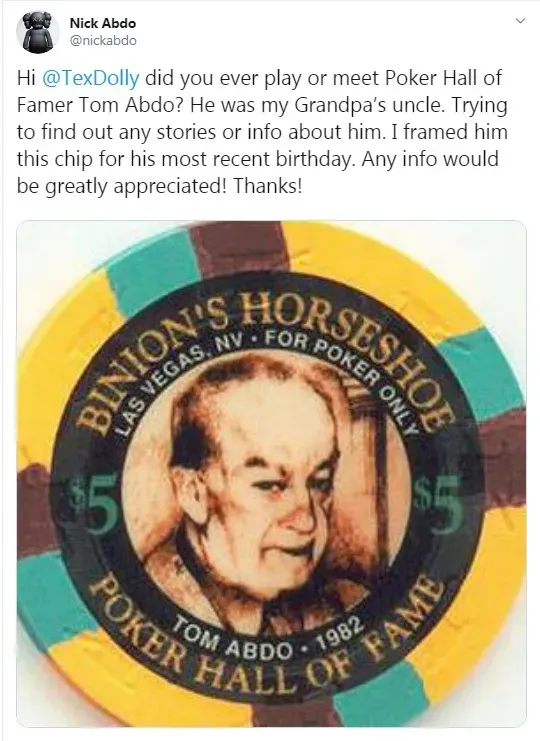
Chips remain an essential part of poker. They represent money on the line as players bet and bluff with them, and they're a big part of what sets poker apart from other games.
As this guide shows, many considerations undoubtedly go into using them.
Poker Chip Values - FAQ
What are poker chip values?
Poker cash games and tournaments use chips to mean specific amounts.
- In a cash game, differing colors represent actual cash values. Poker chips are much easier to play with than actual cash. You can move them around a table easily, unlike cash. They are perfect for exchanging when making change quickly.
- In a tournament, chips don’t represent the actual cash amount that a player uses to buy in.
Instead, these chips represent your starting stacks. As a tournament progresses, blind levels escalate. Players must then play higher chip values. Poker chips offer an easy way to signify and play these escalating values. The goal is to keep collecting those chips and see your own stack rise.
Why do poker players use chips, and what do the poker chip color values mean?
Chips represent a cash value or a tournament chip value. Players use chips to bet during a game or tournament. The goal is to accumulate as many as possible.
- In a cash game, a player can cash out bigger winnings when they decide to leave.
- A player's starting stack of chips does not have to represent the entry fee in a tournament.
However, chips are a player's lifeblood in a tournament – lose them with a bad play or poker bluff, and you’re eliminated. A player who wins a tournament will have collected all the chips in play at the end.
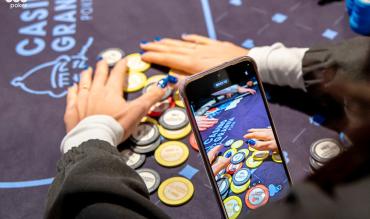
How many chips does a person get in a tournament?
A player will receive the same amount of chips in a tournament as all other players. That starting stack is crucial to surviving the tournament. A tournament follows a specific structure that includes the following:
- Poker chip color values
- Number of chips a player receives
- Time for each blind level and other key constraints
For example, a player in the World Poker Tour Five Diamond Poker Classic at the Bellagio in Las Vegas will pay $10,000 for the entry fee. However, all players start with 40,000 chips. In recent years, the trend in poker has been for more chips for the buy-in, allowing for longer play.
With blinds starting at a tiny 100/100, players have a huge stack in relation to the blinds. This setup offers players much more play for their money and reduced poker variance.
How many chips should a player get in a cash game?
In a cash game, a player's chip stack directly represents the starting stack. As you win or lose, that stack can grow or decrease.
For a $1/$2 No-Limit Hold’em cash game, a player might buy into the game for $200. That amount would be about 100 times the big blind. That player’s chips would represent the actual $200 cash value.
- If that player loses $20 in chips that night, they will cash out for $180.
- A player having a good night and winning $50 worth of chips would cash out for a nice $250.
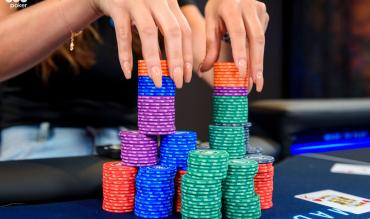
How many chips does a player get at the World Series of Poker?
The answer depends on the event. With buy-ins ranging from $500 to six figures, players will find larger starting stacks for the high buy-in and more prestigious events.
- Players in 2019’s $500 guy-in Big 50 started with 50,000 chips of varying colors and values.
- Blinds started at 100/200 and a 200 big blind ante.
- This setup gave players a starting stack of 250 big blinds.
The special $50K buy-in 50th Annual High Roller event offered players a 300,000-chip starting stack. The blinds started at 1,000/1,000 and a big blind ante of 1,000. This structure gives players a stack worth 300 big blinds.
Generally, the higher the buy-in, the more chips a player gets.
What are the different types of poker chips?
There are generally five types of poker chips when buying chips. A few are more prevalent than others.
- Plastic chips are cheaply made and not a solid option for anyone looking to play serious poker.
- Composite clay chips are exceedingly popular and fairly inexpensive. They are easy to find and can be perfect for a night of poker with friends.
- Composite chips are solid and easy to slide across a poker felt.
- Ceramic chips are of even higher quality and smooth to the touch. They are also easily customisable with individual graphics.
- Lastly, metal or pewter chips are rare but can make for a unique set for a home game. This durable chip style can give your game a real feeling of the Old West.
